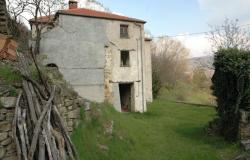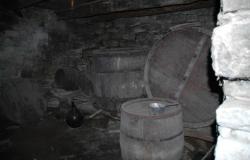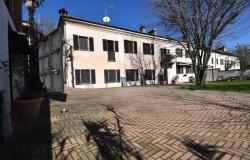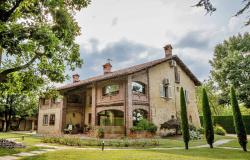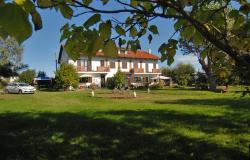Don't Panic [yet]
Submitted by alan h on Wed, 05/05/2010 - 07:39In reply to A newbie all over again! by Annec
It looks like a pretty normal rendering, probably over poor [or very poor] brickwork/stonework. From the pictures, I wouldn't be too worried Render has two purposes - Cosmetic [it looks better than what it is covering] and Weatherproofing [the important one], as it keeps the rain out of the wallls. It shouldn't be considered to be structural The mesh reinforcement serves 2 main purpose. Firstly it is fixed to the wall and helps the thick concrete render stick to the wall. Secondly, it acts as a crack inhibitor, helping to stop the render cracking and letting rain in. It is used where a thick render is used, rather than the more usual thin coat of render [say 5mm - 10mm] that is often applied. They probably used a thick render to cover up a multitude of [the original building] sins, especially in terms of an uneven surface. My main concerns would be whether there is any cracking on either the outside or internal faces of the wall and you say there isn't - which is promising Personally, I would not necessarily go down the 'Engineer' route as a first step. I would get a local Geometra to have a look at it, and seek his/her views, and if he says it should be OK - get it in writing from him. If he cannot give you an acceptable answer I would then get him to recommend an Engineer. Whatever you do - don't ask an Architect Its worth noting that nobody [Geometra, Engineer or Architect] will say its 100% - they will just say that it should be OK Hope this helps Postscript - a good test of how good/sound the render is, is to tap it to see what it sounds like - if it sounds 'hollow' anywhere, it means the render hasn't stuck to the wall in that area, and that could be problematical in terms of weather resistance and 'future falling off'
Don't Panic
Submitted by CW on Wed, 05/05/2010 - 09:56In reply to A newbie all over again! by Annec
Thanks Alan, its easy to sit at a distance and convince yourself of all sorts of possible disaster scenarios. Why do you suggest only going to an engineer after the geometra? Is a geometra really qualified for such a survey? I agree that is not an architect's field.
Why Geometra
Submitted by alan h on Wed, 05/05/2010 - 10:21In reply to Don't Panic by CW
I've had good experiences with geometras, picking them by local recommendation. They are good 'hands-on' people, who [in my opinion] know what they are talking about I trained as a Civil Engineer, [back in the last Millenium], and I believe what you are looking at is non-structural [ie - if the render fell of, the building would remain standing and you could just re-render it]. In which case, and experienced local geometra could easily look at it and say the render is OK. If you are worried about what is under the render, then its a different matter - you'd possibly need an Engineer to strip the render off to do a survey - but I don't think that's what you need [you say there isn't any cracking in the wall] Anyway, I would expect the Geometra to pick up the need for any such intrusive survey. If he recommends such a survey - I would walk away from the house
Thanks again Alan. Time to
Submitted by CW on Thu, 05/06/2010 - 07:25In reply to A newbie all over again! by Annec
Thanks again Alan. Time to
Submitted by CW on Thu, 05/06/2010 - 07:25In reply to A newbie all over again! by Annec
In reply to Thanks again Alan. Time to by CW
best wishes
Submitted by Valentina+c on Mon, 05/10/2010 - 05:24In reply to A newbie all over again! by Annec
I'm not an engineer and my
Submitted by myabruzzohome on Sat, 07/24/2010 - 09:27In reply to A newbie all over again! by Annec
I'm not an engineer and my opinions differ from many others but we have spent 5 years taking apart an old Italian building. Many Italian rusticos are built from limestone which is very soft. Originally they were smply pointed or pointed and covered with a lime and sand ( sometimes earth too) mix called stucco.The stonework was not normally very finely done and gaps or holes were normally quickly filed with any rubble that was around the site. Once cement became popular and cheap the houses were covered in it to consolidate the walls that were usually in a pretty bad way not having been maintained.The problem is that the cement hastens decay and rot in the structure particullary where its cracked and water/frost has penetrated.What is likely to be under the cement is a real mess! My choices would be to tackle the walls by removing the cement and drying out dampness then repointing ( with a lime based mortar made by keracoll - bio calce) .The building will take some time to dry out completely and you may still need to do some other dainage works unless you are very lucky. I've put quite a lot of information on my website.http://www.myabruzzohome.com
I'd concur with all the
Submitted by pilchard on Mon, 07/26/2010 - 04:21In reply to A newbie all over again! by Annec
I'd concur with all the advice given so far but try not to have expensive surveys done on every house you are considering. Ask the agent for a site meeting with a good local Geometra & get him to give you a verbal assessment & price which he is prepared to commit to paper in the form of a preventivo. His survey will form the basis for his quote & will tell you if the structure is poor or not. After some years of first-hand experience, I am not a fan of the widespread use of sand & cement renders in Italian houses. If using it on the outside were not bad enough, the internal walls are also covered in the stuff & this makes for a very unhealthy living environment. Us Brits grew up & lived our entire lives in houses that are"plastered" internally. Plaster regulates the moisture content of the air inside the building by absorbing excess when humidity levels are high & giving it back to the air & the surrounding structure when humidity is low. Plaster is a good thermal insulator whilst sand & cement are not. Coupled with the fact that even modern houses seem to lack effective ventilation, the growth of black mold, especially behind furniture, after a winter period is a clear indicator that the environment is not a healthy one. What does Alan H reckon? Stripping it all of & replacing internally with plaster & re-pointing externally with lime based products like Keracol is the ideal, so long as you can live with the hotch-poch of repairs & other works that have been done to the old walls. Pilch
well ..............
Submitted by alan h on Mon, 07/26/2010 - 06:38In reply to A newbie all over again! by Annec
"Plaster regulates the moisture content of the air inside the building by absorbing excess when humidity levels are high & giving it back to the air & the surrounding structure when humidity is low" Not sure I totally agree with this statement - as once the plaster is painted, it tends to be sealed and its ability to absorb/release water vapour can be very reduced/stopped "........... Coupled with the fact that even modern houses seem to lack effective ventilation, the growth of black mold, especially behind furniture, after a winter period is a clear indicator that the environment is not a healthy one. What does Alan H reckon? ......." My house has a mouldy wall - a combination of the Italian builders inability to understand
- what a damp proof course is
- what a waterproof membrane is
- why you can't build a wall against earth and expect it to be dry
- the need for ventilation in a building
Mould does indicate lack of ventilation, but can also indicate damp penetrating from outside [my wall is built agaist a hillside - old barn many years old]. I keep it under control over the winter shutdown by painting the wall with mould inhibitor - after a few years the inhibitor appears to have soaked into the cement enough to stop [I hope permanently] the growth of mould. If the house needs ventilation over winter - you could fit solar powered ventilators [used in yachting], solar powered ventilator They don't cost a lot and allow you to keep the house well locked up over winter
Hi, I would agree with all
Submitted by Davidjohn on Mon, 07/26/2010 - 07:22In reply to A newbie all over again! by Annec
Hi, I would agree with all that has been said in the technical sense, but what I don't see from you is the overall context for this purchase. You say you are buying to restore, in which case damp-proofing will be part of most/many restoration projects and this process including rendering and plastering will not be the most expensive or complicated part. You certainly need to assure yourself via a competent Geometra that your purchase is structurally sound to begin with and equally importantly able to withstand any planned chages to the living space /room layouts etc. Whether this building is good value vis a vis other properties is more pertinent and of course you would be prepared to be more flexible if this is the house of your dreams. So, in summary, you have been given good advice on the technical aspects of the issues, but these must be placed in the overall context of vlaue for money and your restoration plans. Good luck with everything! David
Remember that if you do get a
Submitted by Penny on Mon, 07/26/2010 - 10:56In reply to A newbie all over again! by Annec
Remember that if you do get a "survey" from a Geometra, it is very important you get the report in writing (not via email only) and that you pay for this "survey" properly with an invoice and IVA. If you don't and you ever want to have some recourse using the document, you will have a hard time proving anything otherwise. I have left the word "survey" in quotes because in my experience in Italy this document bears little resemblance to a survey from a UK surveyor and rarely runs to more than a sheet of A4.
I can surely direct you to a
Submitted by latoca on Fri, 08/20/2010 - 06:49In reply to A newbie all over again! by Annec
I can surely direct you to a good friend of mine, we went to university togetehr and he is an excellent architect: http://www.archmastrangelo.com/; get in touch with Enzo he will be of great help! Paola
You wont go far wrong if you
Submitted by myabruzzohome on Tue, 08/24/2010 - 13:46In reply to A newbie all over again! by Annec
You wont go far wrong if you look at the excellent Period Property Forum - its a UK based forum but everyone there is a period house fanatic and very knowledgeable. There's loads online about plasters absorbing moisture if you google lime plasters you'll find out all about it.Painting breathable plaster or stone with 'plastic' emulsion paints prevents this action from taking place.That's why you need lime wash or clay paints both of which you can buy ready made or if you are keen mix yourself for a fraction of the cost! www.periodproperty.co.uk Period Property forums will tell you exactly why dpc in old stone buildings are a complete waste of money! www.myabruzzohome.com

